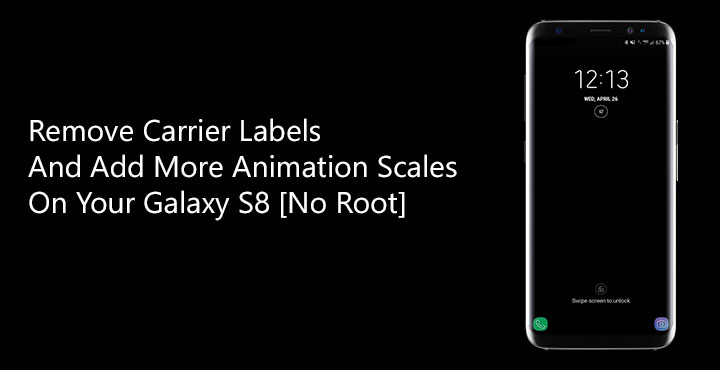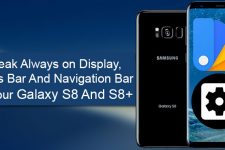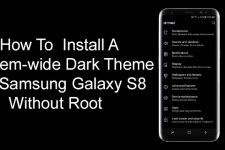
Long long ago in a galaxy not so far away, in the world of Android, when you mentioned the word theme, it was usually superseded by the word “chooser”. It was a nod to T-Mobile’s Theme Chooser made popular by its inclusion in the CyanogenMod custom ROM. It laid the foundations that today make Android a Themer’s paradise. The ability to not only change icons but the entire look and feel of the OS opened a new dimension of customization never before seen except on Linux desktops. But even those don’t have as many options to choose from as users on Android do. The theme chooser evolved into CyanogenMod’s Theme Engine, but it still became obsolete when more advanced engines such as RRO Layers arrived. RRO layers, on the other hand, can be used to remove carrier label and add more animation scales on the Samsung Galaxy S8 and S8+, Samsung’s 2017 flagships.
The History
Note: Honestly, you don’t really need to know this but since you’re going to be using an RRO layers mod, I felt you must know about it. I feel everyone who’s on here would be curious like I am. If you’re not, you should rather scroll down and skip this part.
You may not have heard a lot about RRO layers, it never grew as popular as the CM Theme Engine. And yet, it is the one that still lives on. The foundation for the demise of the CM Theme Engine was laid when Sony’s code contribution was accepted into AOSP. It was in the form of the new framework called Runtime Resource Overlay (RRO). While AOSP was toying with RRO, Sony was doubling down on its efforts towards Android theming. The company began working on OMS (Overlay Manager Service), a client for managing overlays that would allow providers to dynamically control priorities and enable and disable overlays. OMS has been included in AOSP and will appear in Android O.
Meanwhile, a team of developers called Bitsyko had been working with RRO, expanding upon the stock RRO functionality in Android 5.1 Lollipop. This effort came forward in the form of Layers. The first alternative to the CM Theme Engine. But with Sony’s new OMS being merged into the AOSP code, things were not looking good for Layers.
Also read: How to Customize Android Status Bar without Root
TL;DR, OMS caused conflicts with Layers. So to deal with those issues, Bitsyko teamed up again as [projekt.] and created Substratum. Substratum has a mix of both OMS, RRO Layers, and bits and pieces of some other past theming efforts.
How does your Galaxy S8/S8+ tie up into all of this?
Samsung had also been working on its own theming solution to be used across all its devices. Unlike Sony, the Korean giant had no interest in contributing back to AOSP. But since Samsung’s code was basic enough, it wasn’t a big deal really. It first made an appearance on the Galaxy S6 and if you had one, you know it was quite restricted. Over the years Samsung has been developing their theming engine, but as it turns out, Samsung’s theming engine also extends the stock RRO functionality in AOSP. Not only that, the company has worked on its own internal version of OMS as well. Their implementation of both RRO and OMS are obviously different from AOSP, but it’s still essentially the same code.
What this means is that if you have any of the latest Galaxy flagships like the Galaxy S8, you can install RRO overlays and have them theme third party applications. And that does not require any rooting or things that’ll void your warranty.
So now that you’re familiar with RRO layers and why they work on a Samsung Galaxy device, let’s address why you came here in the first place.
How to remove carrier label and add more animation scales to developer settings
Thanks to fate, RRO theming is compatible with Samsung devices. Due to this, developer tytydraco was able to create a couple of mods based on the functionality for the Galaxy S8 and S8+. The first mod removes carrier names from the status bar, both from the status bar and the quick settings panel.
The other mod enables a more precise animation scale setting in the developer options. It adds an interval of 0.1 seconds between the available options instead of a 0.5-second interval.
Don’t miss: 5 Single Purpose Quick Settings Tiles for Android Nougat
Installing the mods is easy Simply download the APK from the link provided below and install it on your phone.
- Remove carrier name overlay
- Add more animation scales overlay
You may also like: 3 Apps That Can Help You Filter Your Screen’s Blue Light
Once installed the overlays should work automatically. If not, try a reboot. Since these are simply overlays, you don’t get an app that you can launch nor do they provide any settings to tinker with. You will simply not see a carrier name anymore on your status bar or the quick settings panel if you installed the respective overlay. If you want to see the animation scales (and maybe change too) just go to Settings > Developer options and scroll down to the Drawing section.
![Remove Carrier Labels And Add A More Animation Scales On Your Galaxy S8 [No Root]](https://www.droidviews.com/wp-content/uploads/2017/08/gs8-01.jpg)
![Remove Carrier Labels And Add A More Animation Scales On Your Galaxy S8 [No Root]](https://www.droidviews.com/wp-content/uploads/2017/08/gs8-03.jpg)



Join The Discussion: